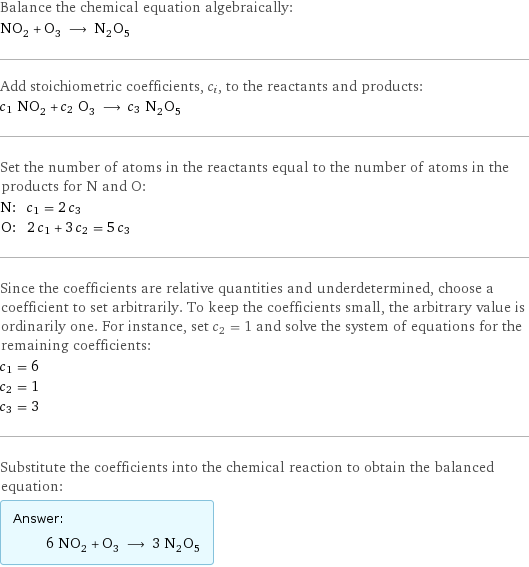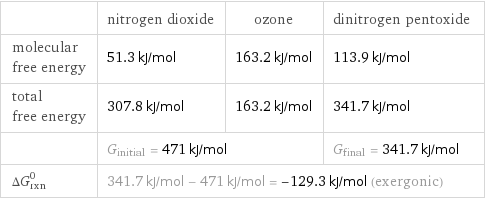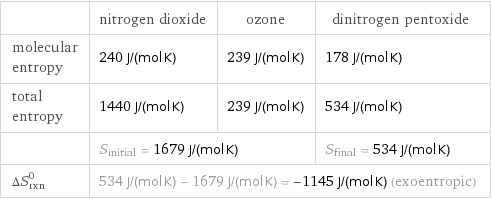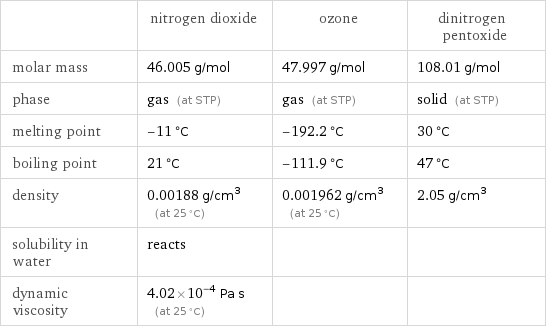Input interpretation

NO_2 nitrogen dioxide + O_3 ozone ⟶ N_2O_5 dinitrogen pentoxide
Balanced equation

Balance the chemical equation algebraically: NO_2 + O_3 ⟶ N_2O_5 Add stoichiometric coefficients, c_i, to the reactants and products: c_1 NO_2 + c_2 O_3 ⟶ c_3 N_2O_5 Set the number of atoms in the reactants equal to the number of atoms in the products for N and O: N: | c_1 = 2 c_3 O: | 2 c_1 + 3 c_2 = 5 c_3 Since the coefficients are relative quantities and underdetermined, choose a coefficient to set arbitrarily. To keep the coefficients small, the arbitrary value is ordinarily one. For instance, set c_2 = 1 and solve the system of equations for the remaining coefficients: c_1 = 6 c_2 = 1 c_3 = 3 Substitute the coefficients into the chemical reaction to obtain the balanced equation: Answer: | | 6 NO_2 + O_3 ⟶ 3 N_2O_5
Structures

+ ⟶
Names

nitrogen dioxide + ozone ⟶ dinitrogen pentoxide
Reaction thermodynamics
Enthalpy

| nitrogen dioxide | ozone | dinitrogen pentoxide molecular enthalpy | 33.2 kJ/mol | 142.7 kJ/mol | -43.1 kJ/mol total enthalpy | 199.2 kJ/mol | 142.7 kJ/mol | -129.3 kJ/mol | H_initial = 341.9 kJ/mol | | H_final = -129.3 kJ/mol ΔH_rxn^0 | -129.3 kJ/mol - 341.9 kJ/mol = -471.2 kJ/mol (exothermic) | |
Gibbs free energy

| nitrogen dioxide | ozone | dinitrogen pentoxide molecular free energy | 51.3 kJ/mol | 163.2 kJ/mol | 113.9 kJ/mol total free energy | 307.8 kJ/mol | 163.2 kJ/mol | 341.7 kJ/mol | G_initial = 471 kJ/mol | | G_final = 341.7 kJ/mol ΔG_rxn^0 | 341.7 kJ/mol - 471 kJ/mol = -129.3 kJ/mol (exergonic) | |
Entropy

| nitrogen dioxide | ozone | dinitrogen pentoxide molecular entropy | 240 J/(mol K) | 239 J/(mol K) | 178 J/(mol K) total entropy | 1440 J/(mol K) | 239 J/(mol K) | 534 J/(mol K) | S_initial = 1679 J/(mol K) | | S_final = 534 J/(mol K) ΔS_rxn^0 | 534 J/(mol K) - 1679 J/(mol K) = -1145 J/(mol K) (exoentropic) | |
Equilibrium constant
![Construct the equilibrium constant, K, expression for: NO_2 + O_3 ⟶ N_2O_5 Plan: • Balance the chemical equation. • Determine the stoichiometric numbers. • Assemble the activity expression for each chemical species. • Use the activity expressions to build the equilibrium constant expression. Write the balanced chemical equation: 6 NO_2 + O_3 ⟶ 3 N_2O_5 Assign stoichiometric numbers, ν_i, using the stoichiometric coefficients, c_i, from the balanced chemical equation in the following manner: ν_i = -c_i for reactants and ν_i = c_i for products: chemical species | c_i | ν_i NO_2 | 6 | -6 O_3 | 1 | -1 N_2O_5 | 3 | 3 Assemble the activity expressions accounting for the state of matter and ν_i: chemical species | c_i | ν_i | activity expression NO_2 | 6 | -6 | ([NO2])^(-6) O_3 | 1 | -1 | ([O3])^(-1) N_2O_5 | 3 | 3 | ([N2O5])^3 The equilibrium constant symbol in the concentration basis is: K_c Mulitply the activity expressions to arrive at the K_c expression: Answer: | | K_c = ([NO2])^(-6) ([O3])^(-1) ([N2O5])^3 = ([N2O5])^3/(([NO2])^6 [O3])](../image_source/b29d3ebad6f79623dcc3b6f0e0079d6a.png)
Construct the equilibrium constant, K, expression for: NO_2 + O_3 ⟶ N_2O_5 Plan: • Balance the chemical equation. • Determine the stoichiometric numbers. • Assemble the activity expression for each chemical species. • Use the activity expressions to build the equilibrium constant expression. Write the balanced chemical equation: 6 NO_2 + O_3 ⟶ 3 N_2O_5 Assign stoichiometric numbers, ν_i, using the stoichiometric coefficients, c_i, from the balanced chemical equation in the following manner: ν_i = -c_i for reactants and ν_i = c_i for products: chemical species | c_i | ν_i NO_2 | 6 | -6 O_3 | 1 | -1 N_2O_5 | 3 | 3 Assemble the activity expressions accounting for the state of matter and ν_i: chemical species | c_i | ν_i | activity expression NO_2 | 6 | -6 | ([NO2])^(-6) O_3 | 1 | -1 | ([O3])^(-1) N_2O_5 | 3 | 3 | ([N2O5])^3 The equilibrium constant symbol in the concentration basis is: K_c Mulitply the activity expressions to arrive at the K_c expression: Answer: | | K_c = ([NO2])^(-6) ([O3])^(-1) ([N2O5])^3 = ([N2O5])^3/(([NO2])^6 [O3])
Rate of reaction
![Construct the rate of reaction expression for: NO_2 + O_3 ⟶ N_2O_5 Plan: • Balance the chemical equation. • Determine the stoichiometric numbers. • Assemble the rate term for each chemical species. • Write the rate of reaction expression. Write the balanced chemical equation: 6 NO_2 + O_3 ⟶ 3 N_2O_5 Assign stoichiometric numbers, ν_i, using the stoichiometric coefficients, c_i, from the balanced chemical equation in the following manner: ν_i = -c_i for reactants and ν_i = c_i for products: chemical species | c_i | ν_i NO_2 | 6 | -6 O_3 | 1 | -1 N_2O_5 | 3 | 3 The rate term for each chemical species, B_i, is 1/ν_i(Δ[B_i])/(Δt) where [B_i] is the amount concentration and t is time: chemical species | c_i | ν_i | rate term NO_2 | 6 | -6 | -1/6 (Δ[NO2])/(Δt) O_3 | 1 | -1 | -(Δ[O3])/(Δt) N_2O_5 | 3 | 3 | 1/3 (Δ[N2O5])/(Δt) (for infinitesimal rate of change, replace Δ with d) Set the rate terms equal to each other to arrive at the rate expression: Answer: | | rate = -1/6 (Δ[NO2])/(Δt) = -(Δ[O3])/(Δt) = 1/3 (Δ[N2O5])/(Δt) (assuming constant volume and no accumulation of intermediates or side products)](../image_source/0c4e5e664ccef9a424fcd095bd3cbde6.png)
Construct the rate of reaction expression for: NO_2 + O_3 ⟶ N_2O_5 Plan: • Balance the chemical equation. • Determine the stoichiometric numbers. • Assemble the rate term for each chemical species. • Write the rate of reaction expression. Write the balanced chemical equation: 6 NO_2 + O_3 ⟶ 3 N_2O_5 Assign stoichiometric numbers, ν_i, using the stoichiometric coefficients, c_i, from the balanced chemical equation in the following manner: ν_i = -c_i for reactants and ν_i = c_i for products: chemical species | c_i | ν_i NO_2 | 6 | -6 O_3 | 1 | -1 N_2O_5 | 3 | 3 The rate term for each chemical species, B_i, is 1/ν_i(Δ[B_i])/(Δt) where [B_i] is the amount concentration and t is time: chemical species | c_i | ν_i | rate term NO_2 | 6 | -6 | -1/6 (Δ[NO2])/(Δt) O_3 | 1 | -1 | -(Δ[O3])/(Δt) N_2O_5 | 3 | 3 | 1/3 (Δ[N2O5])/(Δt) (for infinitesimal rate of change, replace Δ with d) Set the rate terms equal to each other to arrive at the rate expression: Answer: | | rate = -1/6 (Δ[NO2])/(Δt) = -(Δ[O3])/(Δt) = 1/3 (Δ[N2O5])/(Δt) (assuming constant volume and no accumulation of intermediates or side products)
Chemical names and formulas

| nitrogen dioxide | ozone | dinitrogen pentoxide formula | NO_2 | O_3 | N_2O_5 name | nitrogen dioxide | ozone | dinitrogen pentoxide IUPAC name | Nitrogen dioxide | ozone | nitro nitrate
Substance properties

| nitrogen dioxide | ozone | dinitrogen pentoxide molar mass | 46.005 g/mol | 47.997 g/mol | 108.01 g/mol phase | gas (at STP) | gas (at STP) | solid (at STP) melting point | -11 °C | -192.2 °C | 30 °C boiling point | 21 °C | -111.9 °C | 47 °C density | 0.00188 g/cm^3 (at 25 °C) | 0.001962 g/cm^3 (at 25 °C) | 2.05 g/cm^3 solubility in water | reacts | | dynamic viscosity | 4.02×10^-4 Pa s (at 25 °C) | |
Units
